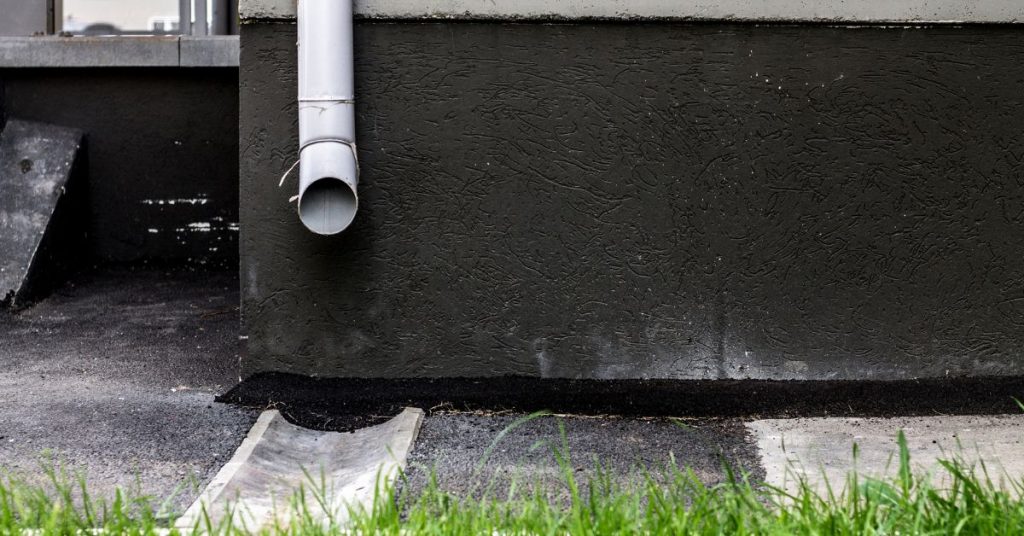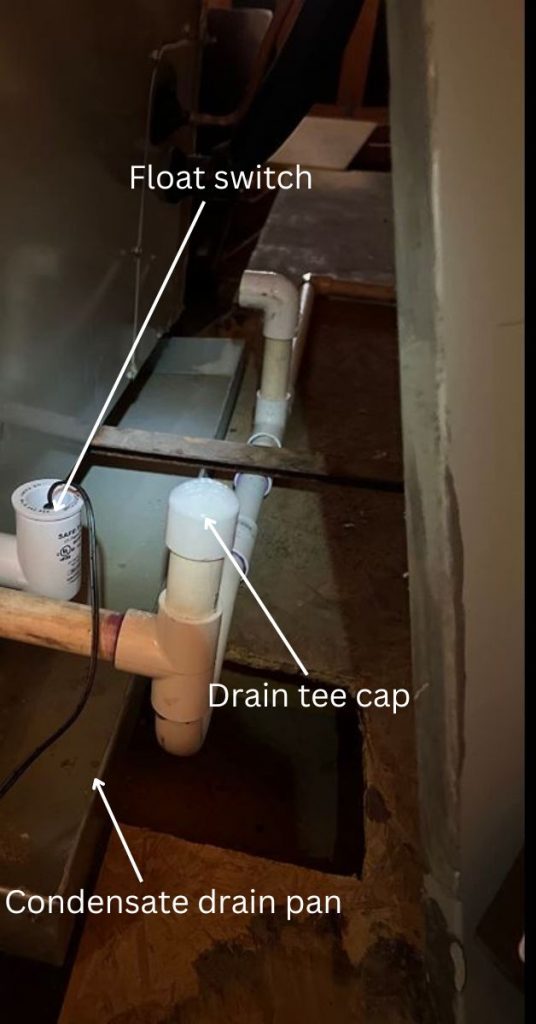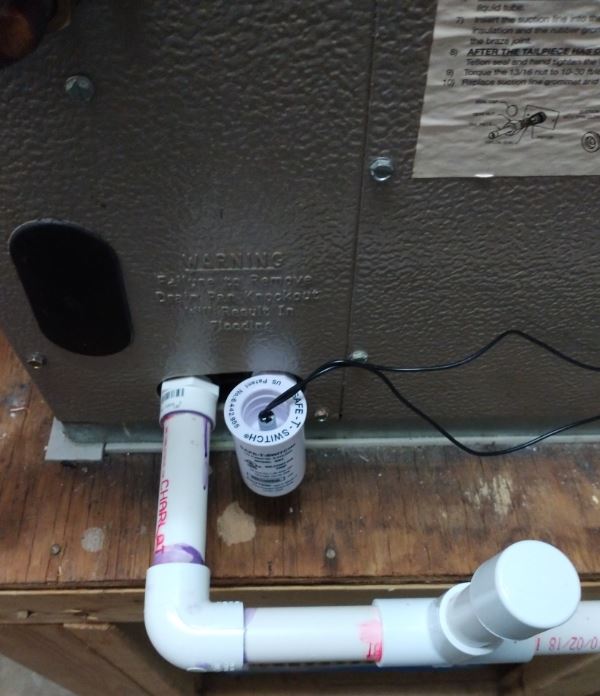
A clogged air conditioner (AC) drain line can lead to water leakage, reduced cooling efficiency, and potential damage to your HVAC system. Unclogging the drain line is essential for maintaining the system’s performance. Here’s a summary of effective ways to unclog your AC drain line:
- Safety Precautions: Ensure the AC is turned off to prevent electrical hazards. Wear protective gear like gloves and safety glasses.
- Locate the Drain Line: Identify the AC drain line, which is typically a PVC or plastic pipe running from the indoor unit to the exterior or a drainage system.
- Inspect for Clogs: Check for visible clogs, debris, or algae buildup in the drain line. If you see blockages, try to remove them manually with a pipe cleaning brush or a straightened coat hanger.
- Use a Wet/Dry Vacuum: Attach the hose of a wet/dry vacuum to the end of the drain line, ensuring a tight seal. Turn on the vacuum to create suction within the line. This will help dislodge and remove clogs.
- Listen for Clear Flow: Listen for a clear flow of air, indicating that the clogs have been removed from the drain line. This may take a few minutes.
- Flush with Water and Bleach: After using the vacuum, flush the drain line with a mixture of water and bleach (approximately one cup of bleach per gallon of water). Pour this solution into the drain line to help prevent future algae growth and maintain cleanliness.
- Unclogging From the Exterior: If the clog is closer to the exterior end of the drain line, you can also attempt to clear it from that side. Remove the access cap or plug and use a drain snake or a hose with high-pressure water to dislodge the blockage.
- Regular Maintenance: To avoid future clogs, consider implementing regular maintenance practices, including changing air filters, inspecting the drain line, and scheduling professional AC checkups.
- Professional Assistance: If your attempts to unclog the drain line are unsuccessful, or if you’re uncomfortable performing these tasks, seek professional HVAC assistance. Experienced technicians can diagnose and address more complex issues and ensure your AC system operates optimally.
What Causes AC Drain Lines to Clog
As I have mentioned, the AC condensate drain pan is located directly under the evaporator coil. One thing about the area around the evaporator coil is that it is very humid.
The humidity creates a perfect breeding ground for algae, mold, mildew and other such organisms. These organisms multiply inside the AC drain line and if the line is not cleaned regularly they will completely block it off.
Another thing that can cause the AC drain line to clog is dust, pollen, lint and other particles from the return air (air from the house). Although the AC has an air filter, some particles will still manage to pass through it.
Failing to change the AC filter can also cause the condensate drain line to clog. The dirt embeds on the evaporator coil while some drips out with condensate and end up trapped inside the drain line where it causes a clog.
How to Tell if Your AC Drain Line is Clogged

As I mentioned, air conditioners can produce up to 30 gallons of condensate in a day. If then an AC line is clogged, all of that water can end up spilling on the floor/ceiling resulting in expensive repairs.
But that hardly happens. That is because your air conditioner is fitted with a failsafe device known as a float switch.
When the AC drain line is clogged, water will not be drained out of the drip pan, meaning that it will raise in level. A float switch is located inside the secondary drain pain in horizontal units or drain line in vertical units.
When the level of condensate in the pan rises, the float rises with it until it reaches a critical level where it will break contact between 2 electrical contacts. When that happens, current can longer pass through the AC system and therefore the AC will turn off.
If the AC is off, the evaporator coil will not form any more condensate. Because of that, the drip pan cannot overflow saving your from water damage.
The 2 most obvious signs of a clogged AC drain line is an AC that won’t turn on and a condensate drain pan full of water. If you don’t have an AV float switch or if it has malfunctioned, the drip pan will overflow with water.
And now the following are the 3 ways to unclog an air conditioner condensate drain line:
1. How to Unclog an AC Drain Line Using a Shop Vac
If you can find a shop vac (can even be hired from your local hardware store), this is the easiest and fastest way to clear a clogged AC drain line. It is also very effective.
This is how to unclog an AC drain line using a shop vac:
- Locate you AC drain line outside the house. It will be a PVC pipe usually very close to the condenser unit.
- Connect the shop vac’s hose to the drain line. Use a piece of rag or duct tape to help you create a tight seal.
- Run the shop vac for a minute.
- Dash back to the house (where your HVAC indoor unit is located) and check if the drip pan has been drained out as well.
Usually, after clearing the clog the water inside the drain pan should drain out as well. When the water level in the drain pan drops, the float mechanism in the float switch will drop as well, reestablishing the contact between the 2 electrical probes.
In short, draining the drain pan will reset the float switch and the AC will kick in again and start running.
2. How to Unclog an AC Drain Line Using Vinegar

If you don’t have a shop vac, you can attempt to clear the AC drain line using vinegar. It will take longer to work but in most of the time it will work.
Vinegar is a weak acid which will break down the clog and in the process clear the line. You may or may not add baking soda to it.
Here is how to clear an AC drain line using vinegar:
- Start by turning off the AC from the thermostat and electrical panel to remove the risk or electrical shock.
- Locate the AC drain line access tee. The tee is a small PVC piece with a cap at the top.
- Remove the cap from the tee. You don’t need any tool to do that.
- With the cap out, check if you can see any visible gunk inside the drain line. Remove as much of it as possible.
- Pour one cup of distilled vinegar down the drain pipe and wait for about 30 minutes. You can opt to pour 1 cup of baking soda followed by another cup of vinegar. The combination works together very well.
- After the 30 minutes, flush the AC drain line with hot water. Hot water on its own is known to clear clogs. The hot water will therefore break and flush out any clog still left inside the pipe.
Note: To be sure that the AC drain line is fully unclogged, place a bucket under the drain line outside the house prior to pouring out the water, or else have someone have a look as you pour the water.
3. How to Snake a Clogged AC Drain Line
For stubborn clogs, you may need to snake the AC drain line. For that you can either use a plumber snake or a garden hose.
I would suggest that you first try with a garden house since most of the time the clog is not that far from the drain access tee. You can actually see that the drain line curves a few inches from the tee.
The curve on the drain line creates a bit of restriction and that is where most of the clogs are located. A garden house will therefore reach and break down the clog with ease.
Here is how to snake an AC drain line:
- Remove the drain access tee cap.
- Slowly insert the garden hose or plumber’s snake down the drain line (being careful that it doesn’t go towards the AC unit) until you encounter a restriction.
- If you have a garden hose, use it to break the clog by pulling it up and pushing it down repeatedly until the hose extends past the restriction.
- If you have a plumber’s snake, turn the snake handle until the head of the snake penetrates through the clog.
- Slowly pull out the snake/hose.
- Flush the line with water and have someone check if the same water is come out of the drain line outside the house.
And basically that is how to unclog an air conditioner condensate drain line.
How to Prevent the AC Drain Line from Clogging
To prevent your AC drain line from clogging, it is important to have regular scheduled maintenance by a professional HVAC technician.
Apart from cleaning the condensate drain line, the technician will inspect and clean the ductwork, clean evaporator coils, change AC filters, check refrigerant level among other things.
On your own, you can make it a habit to regularly pour a cup of distilled vinegar down the AC drain line. The vinegar will prevent the formation of clogs making sure that the line is always discharging the condensate.
You can also opt to use the shop vac to clean the drain line after every few months. Just connect the vac’s hose to the drain line and sack out the gunk from the drain line before it forms a clog.
Also, you don’t have to bring in a technician to change the AC filter for you. You can easily change your AC’s filter in a few minutes.
Wrap Up
And basically that is how you can unclog your air conditioner’s condensate drain line on your own. As you can see, preventing the clog is even easier than having to deal with the clog.





